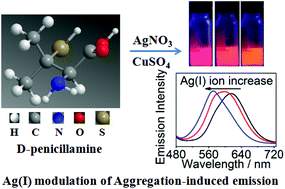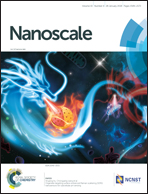d-Penicillamine-coated Cu/Ag alloy nanocluster superstructures: aggregation-induced emission and tunable photoluminescence from red to orange†
Abstract
The aggregation-induced emission (AIE) behavior of metal nanoclusters has attracted much attention owing to their extensive application prospects in bio-imaging and chemical sensors. However, the intrinsic mechanism of metal nanoclusters’ aggregation-induced emission is still not very clear. Herein, Cu nanoclusters S1 and Ag(I)-doped Cu/Ag nanoclusters S2 and S3 coated with D-penicillamine are designed and synthesized by a self-assembly strategy. S1–S3 show strong luminescence properties with luminescence quantum yields as high as 11.4%–14.2%. Moreover, their luminescence peak position shows an obvious hypsochromic shift from 615 (S1) to 570 nm (S3). With the introduction of Ag(I) ions, the assembly morphology also shows clear changes from the irregular assembly structure (S1) to large spherical particles with the average size of 0.18 μm for S2 and 0.47 μm for S3. A detailed investigation of high-resolution transmission electron microscopy (HRTEM) images, X-ray diffraction (XRD) patterns, ESI-TOF-mass spectra, UV-vis absorption spectra, photoluminescence spectra and luminescence lifetimes of Cu/Ag nanoclusters S2 and S3 indicates that Cu/Ag nanoclusters are actually a Cu/Ag alloy nanocluster superstructure and the microscopic arrangement of S2 and S3 is more compact and ordered relative to S1. The more compact and ordered Cu/Ag alloy nanocluster superstructure enhances the metal–metal interaction of inter-nanoclusters and intra-nanoclusters and facilitates the radiative transition of ligand-to-metal charge transfer (LMCT) and/or ligand-to-metal–metal charge transfer (LMMCT), which results in the aggregation-induced emission phenomenon. In addition, an enhanced metal–metal interaction increases the average metal–metal distance of the Cu/Ag nanocluster superstructure, leading to a hypsochromic shift of emission spectra. Furthermore, the Cu/Ag alloy nanoclusters show good stability and reversibility on pH cycling between pH = 3 and 7 and temperature cycling between 5 °C and 48 °C. The Cu/Ag alloy nanoclusters can be used as probes for Ag(I) ion and halide anion detection in real water samples by the ratiometric PL method (I570/I615).



 Please wait while we load your content...
Please wait while we load your content...